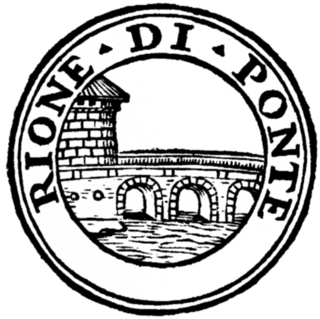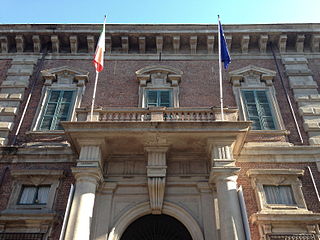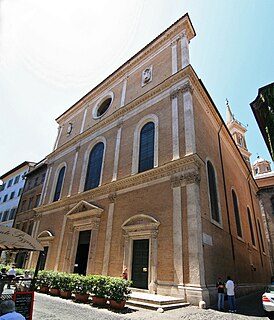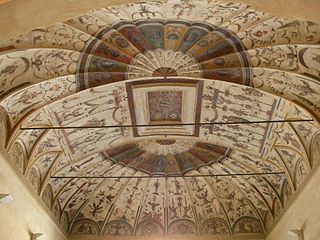Santa Maria dell'Angelo, also known as Santa Maria Nuova is a Baroque architecture, Roman Catholic church, erected by the Jesuit Order on Via Santa Maria dell'Angelo in Faenza, Italy.
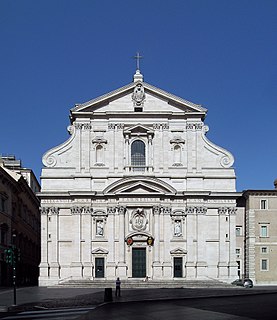
Baroque architecture is the building style of the Baroque era, begun in late 16th-century Italy, that took the Roman vocabulary of Renaissance architecture and used it in a new rhetorical and theatrical fashion, often to express the triumph of the Catholic Church. It was characterized ..by new explorations of form, light and shadow, and dramatic intensity. Common features of Baroque architecture included gigantism of proportions; a large open central space where everyone could see the altar; twisting columns, theatrical effects, including light coming from a cupola above; dramatic interior effects created with bronze and gilding; clusters of sculpted angels and other figures high overhead; and an extensive use of trompe-l'oeil, also called "quadratura," with painted architectural details and figures on the walls and ceiling, to increase the dramatic and theatrical effect.

Faenza is an Italian city and comune, in the province of Ravenna, Emilia-Romagna, situated 50 kilometres southeast of Bologna.

Italy, officially the Italian Republic, is a country in Europe. Located in the middle of the Mediterranean Sea, Italy shares open land borders with France, Switzerland, Austria, Slovenia and the enclaved microstates San Marino and Vatican City. Italy covers an area of 301,340 km2 (116,350 sq mi) and has a largely temperate seasonal and Mediterranean climate. With around 61 million inhabitants, it is the fourth-most populous EU member state and the most populous country in Southern Europe.
Construction began in 1621, and the cupola was finally erected in 1646, when the original architect Girolamo Rainaldi was substituted by Ercole Fichi. The facade remains incomplete. The main altarpiece, placed here in 1778, painted in a Renaissance style, was by an unknown artist, but attributed by some to Sigismondo Foschi. [1]
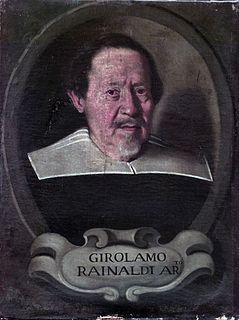
Girolamo Rainaldi was an Italian architect who worked mainly in a conservative Mannerist style, often with collaborating architects. He was a successful competitor of Bernini. His son, Carlo Rainaldi, became an even more notable, more fully Baroque architect.

Renaissance art is the painting, sculpture and decorative arts of the period of European history, emerging as a distinct style in Italy in about 1400, in parallel with developments which occurred in philosophy, literature, music, and science. Renaissance art, perceived as the noblest of ancient traditions, took as its foundation the art of Classical antiquity, but transformed that tradition by absorbing recent developments in the art of Northern Europe and by applying contemporary scientific knowledge. Renaissance art, with Renaissance Humanist philosophy, spread throughout Europe, affecting both artists and their patrons with the development of new techniques and new artistic sensibilities. Renaissance art marks the transition of Europe from the medieval period to the Early Modern age.
Sigismondo Foschi, also called Sigismondo da Faenza was and Italian painter of the Renaissance period, born and active in Faenza. He was likely a pupil of Giovanni Antonio Sogliani. As a young man, in 1520, he assisted his father in completing an altarpiece in a chapel in San Francesco in Faenza. Sigismondo’s father, Antonio, was a gold and silversmith. Sigismondo painted an Assumption of the Virgin (1522) for the church of Santa Maria della Terra at Solarolo. He painted a Madonna and child with saints (1527) for the church of San Bartolomeo in Faenza. Other sundry works are assigned to the painter without definitive attribution. An altarpiece of Madonna and child with Saints Paul, John the Baptist, Benedict (?), Sebastian, Catherine and Apollonia, originally from the church of Santa Maria ad Nives, is found in the Pinacoteca of Faenza. Documents establish that he died by 1536.


